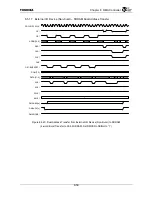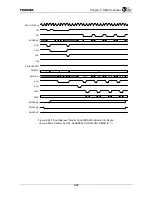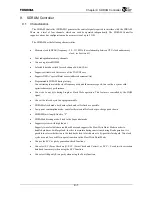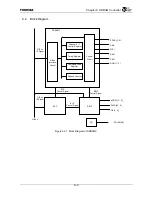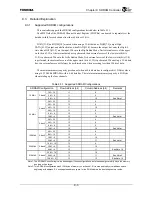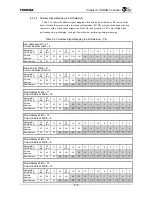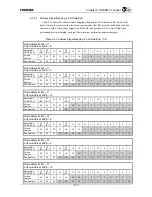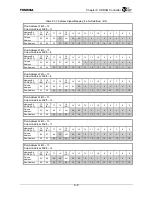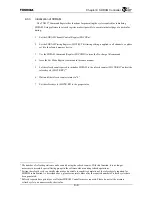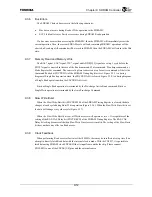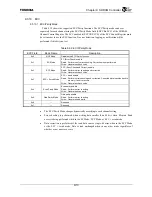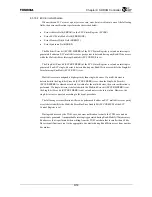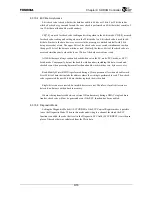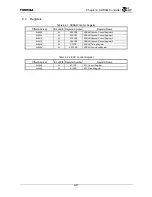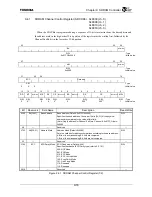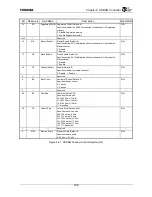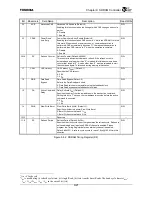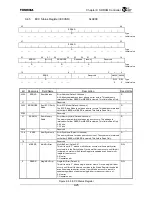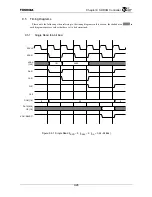
Chapter 9 SDRAM Controller
9-11
9.3.5
Low Power Consumption Function
9.3.5.1 Power Down Mode, Self-Refresh Mode
SDRAM has two low power consumption modes called the Power Down mode and the Self-
Refresh mode. Memory data is lost in the case of the Power Down mode since Memory Refresh is
not performed, but the amount of power consumed is reduced the most. Memory data is not lost in
the case of the Self-Refresh mode.
SDRAM is set to the Power Down mode by using the SDRAM Command Register (SDCCMD)
to issue the Power Down Mode command. Similarly, SDRAM is set to the Self-Refresh mode by
issuing the Self-Refresh Mode command. The SDRAMC terminates internal refresh circuit
operation after one of these commands has been issued. Issuing the Normal Mode command
returns operation to normal.
When the Power Down Auto Entry bit (SDCTR.PDAE) of the SDRAM Timing Register is set,
SDRAM is automatically set to the Power Down mode when memory access is not being
performed. The SDRAMC internal refresh circuit will continue operating, so there will be no loss
of memory data.
If either the Memory Access, Memory Refresh, or Memory command is executed while
SDRAM is set to the Power Down mode or the Self-Refresh mode, then the Power Down mode
and Self-Refresh mode will automatically terminate, and memory access will be performed.
After returning from a low power consumption mode that was set by either the Power Down
Mode command or the Self-Refresh Mode command, the next memory access starts after 10
SDCLK cycles pass. This latency sufficiently follows the stipulated time from Power Down to
first access of the SDRAM.
If setting the Power Down Auto Entry bit automatically causes memory access to be requested
when set in the Power Down mode, then add 1 SDCLK cycle more of access latency than when
not in the Power Down mode.
9.3.5.2 Advanced
CKE
Advanced CKE is a function that speeds up the CKE assertion and deassertion timing by 1
clock cycle. This function is set using the Address CKE bit (SDCTR.ACE) of the SDRAM Timing
Register.
Advanced CKE assumes that it will be used in a system where SDRAM data is saved even
when the power to the TX4937 itself is cut. Since CKE On/Off becomes 1 cycle faster, it is
possible to delay CKE by 1 clock cycle using external power consumption control logic. Please set
the SDRAM to the Self-Refresh mode before using this function.
When combining advanced CKE functionality with Power Down Auto Entry functionality and
memory access is requested while in the Power Down mode, two more SDCLK cycles of latency
are added than would be the case when not in the Power Down mode.
Summary of Contents for TX49 TMPR4937
Page 1: ...64 Bit TX System RISC TX49 Family TMPR4937 Rev 2 0 ...
Page 4: ......
Page 13: ...Table of Contents ix TMPR4937 Revision History 1 ...
Page 14: ...Table of Contents x ...
Page 15: ...Handling Precautions ...
Page 16: ......
Page 18: ...1 Using Toshiba Semiconductors Safely 1 2 ...
Page 40: ...3 General Safety Precautions and Usage Considerations 3 18 ...
Page 42: ...4 Precautions and Usage Considerations 4 2 ...
Page 43: ...TMPR4937 2005 3 Rev 2 0 ...
Page 44: ......
Page 52: ...Chapter 1 Overview and Features 1 6 ...
Page 156: ...Chapter 7 External Bus Controller 7 56 ...
Page 491: ...Chapter 16 Removed 16 1 16 Removed ...
Page 492: ...Chapter 16 Removed 16 2 ...
Page 493: ...Chapter 17 Removed 17 1 17 Removed ...
Page 494: ...Chapter 17 Removed 17 2 ...
Page 495: ...Chapter 18 Removed 18 1 18 Removed ...
Page 496: ...Chapter 18 Removed 18 2 ...
Page 497: ...Chapter 19 Removed 19 1 19 Removed ...
Page 498: ...Chapter 19 Removed 19 2 ...
Page 506: ...Chapter 20 Extended EJTAG Interface 20 8 ...
Page 530: ...Chapter 22 Pinout and Package Information 22 10 ...
Page 542: ...Chapter 24 Parts Number when Ordering 24 2 ...



